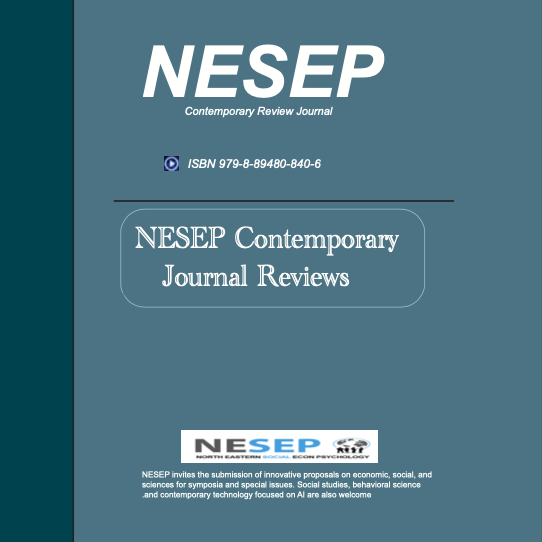Accepted Articles
We congratulate you on acceptance of your manuscript.

Annual Expo by the Journal of Young Explorers Meta and NESEP
- Fundamental or applied research
- Interdisciplinary research
- Judging on a rolling basis
- A work-in-progress research
- Completed research
- Unlimited topics and ideas
- ISBN 979-8-89480-840-6
- NESEP/NY-CSEF event at Harvard Club in NYC
Evaluating Gender Differences in the Effects of Ambiguity and Misperception on Entrepreneurship in Three Business Development Stages: A Panel Data Analysis
Abstract:
This research focuses on the role of uncertainty in explaining gender disparities in entrepreneurship by testing a behavioral decision model. It examines how misperceptions and ambiguity affect men’s and women’s decisions on founding startups or maintaining established firms in developed and developing countries. It starts from the theoretical assumption that entrepreneurial decision-making follows cumulative prospect theory, the Ellsberg paradox, and loss aversion as in the Allais paradox. Data from the Global Entrepreneurship Monitor in 46 countries/territories over 2013 – 2019 was used for a panel data econometric analysis using fixed-effects and Generalized Least Squares (GLS) models. Findings indicate that there are clear gender differences in behavioral characteristics of entrepreneurs in the face of varying uncertainty levels according to three business development stages. During the startup stage, confidence in ability and confidence from knowing an entrepreneur is positively associated with entrepreneurial prevalence, whereas fearing the worst is negatively associated. Gender-bias “discount factors” progressively hinder women as the business develops, particularly in developing countries. During the established business stage, fearing the worst, confidence, and high reference points are positively associated, especially for women’s entrepreneurship. Due to a self-selection effect, once women can enter the scale-up stage, they are more likely than men to continue to the established business stage. Effective policies should consider the specific needs of women and the barriers that they face when setting up and sustaining businesses.
Reference
[1] T. Adachi and T. Hisada, "Gender differences in entrepreneurship and intrapreneurship: an empirical analysis," Small Business Economics, vol. 48, no. 3, pp. 447-486, 2017. Retrieved from http://www.jstor.org/stable/26154737.
[2] M. Arellano and B. Honore, “Panel data models: Some recent developments” in Handbook of Econometrics (J.J. Heckman and E. Lemur), 3229-3296, Elsevier, 2001.
[3] I. Chadwick and A. Dawson, "From imposter fears to authenticity: a typology of women entrepreneurs," Small Business Economics, 2023. Retrieved from https://doi.org/10.1007/s11187-023-00795-x.
[4] B. Chung, P. Franses, and E. Pennings, "Conditions that make ventures thrive: from individual entrepreneur to innovation impact," Small Business Economics, 2023. Retrieved from https://doi.org/10.1007/s11187-023-00800-3.
[5] C. Harris and M. Jenkins, "Gender differences in risk assessment: Why do women take fewer risks than men?" Judgment and Decision Making, vol. 1, no. 1, pp. 48-63, 2006.
[6] S. Hügelschäfer and A. Achtziger, "On confident men and rational women: It’s all on your mind(set)," Journal of Economic Psychology, vol. 41, pp. 31-44, 2014. Retrieved from https://doi.org/10.1016/j.joep.2013.04.001.
[7] D. Hechavarría and A. Ingram, "Entrepreneurial ecosystem conditions and gendered national-level entrepreneurial activity: A 14-year panel study of GEM," Small Business Economics, vol. 53, pp. 431-458, 2019. Retrieved from https://doi.org/10.1007/s11187-018-9994-7.
[8] A. Invernizzi, A. Menozzi, D. Passarani, D. Patton, and G. Viglia, "Entrepreneurial overconfidence and its impact upon performance," International Small Business Journal, vol. 35, no. 6, pp. 709-728, 2017. Retrieved from https://doi.org/10.1177/0266242616678445.
[9] F. Knight, Risk, Uncertainty and Profit. Boston, NY: Houghton Mifflin Company, 1921.
[10] G. Liu and W. Spanjers, "Modeling uncertainties and gender differences in entrepreneurial decision making," Working Paper series 23-15, Rimini Centre for Economic Analysis, 2023. Retrieved from https://ideas.repec.org/p/rim/rimwps/23-15.html.
[11] S. Prasad, R. Kiran, and R. Sharma, "Behavioural, socio-economic factors, financial literacy and investment decisions: Are men more rational and women more emotional?" The Indian Economic Journal, vol. 69, no. 1, 2021. Retrieved from https://doi.org/10.1177/0019466220987023.
[12] E. Sent and I. van Staveren, "A feminist review of behavioral economic research on gender differences," Feminist Economics, vol. 25, no. 2, pp. 1-35, 2019. Retrieved from https://doi.org/10.1080/13545701.2018.1532595.
[13] A. Tversky and D. Kahneman, “Advances in prospect theory: Cumulative representation of uncertainty,” Journal of Risk and Uncertainty, vol. 5, no. 5, pp. 297-323, 1992.
[14] P. Wakker, Prospect Theory for Risk and Ambiguity. Cambridge, UK: Cambridge University Press, 2010.
[15] M, Woolcock and D. Narayan, “Social capital: implications for development theory, research, and policy,” World Bank Research Observer, vol. 15, no. 2, pp. 225-249, 2000.
[16] World Bank, "The World by Income and Region," 2022. Retrieved from https://datatopics.worldbank.org/world-development-indicators/the-world-by-income-and-region.html.